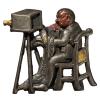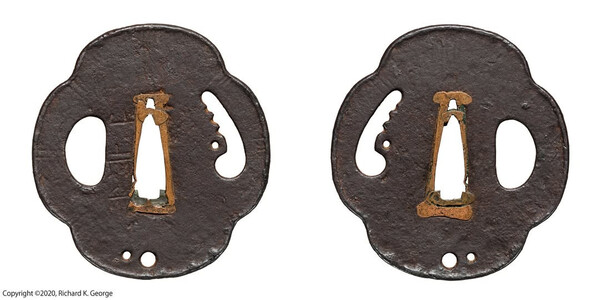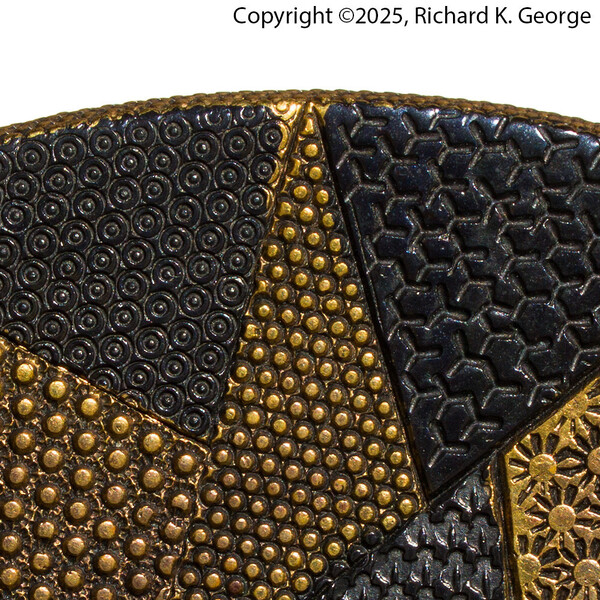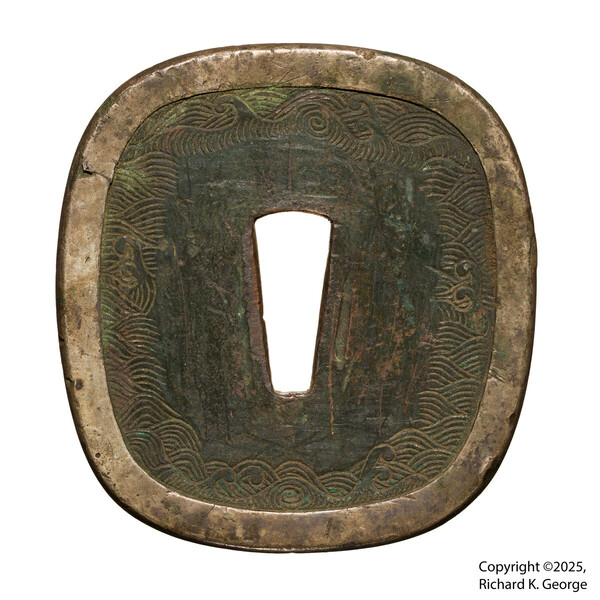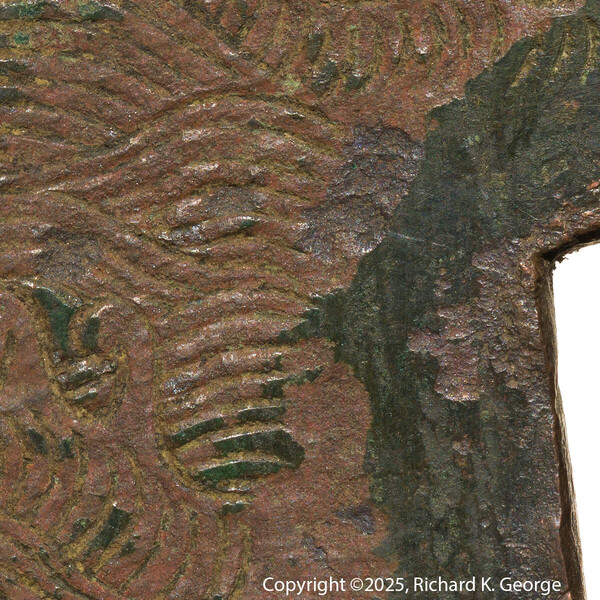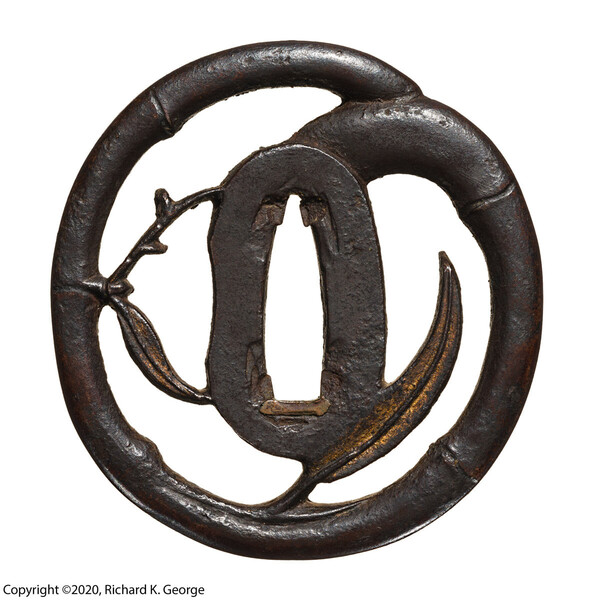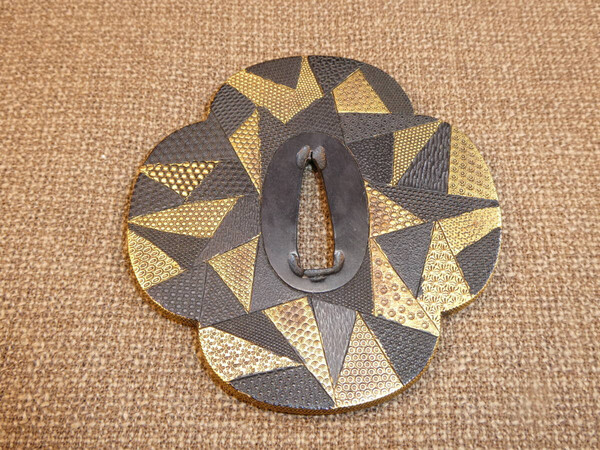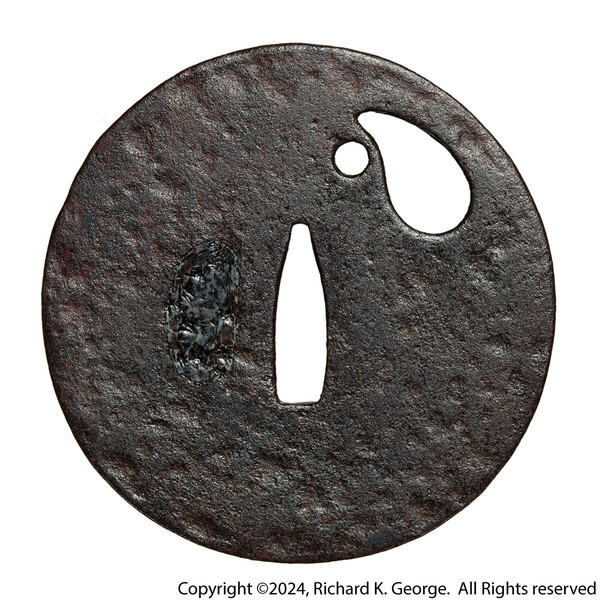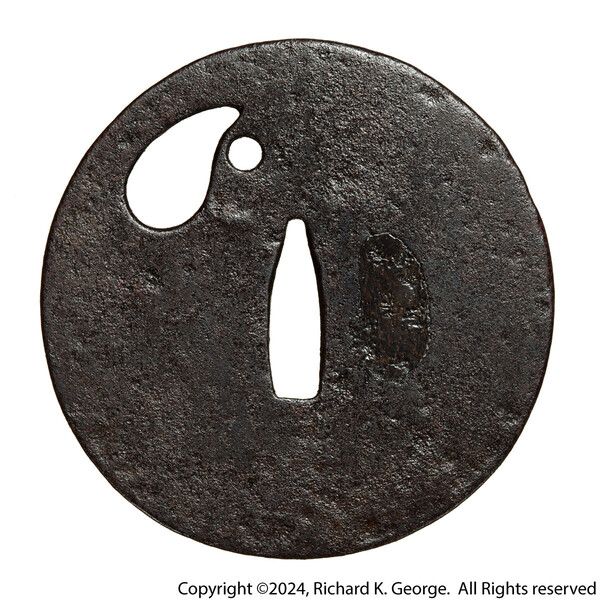-
Posts
835 -
Joined
-
Last visited
-
Days Won
7
Content Type
Profiles
Forums
Events
Store
Downloads
Gallery
Everything posted by rkg
-
HI, Has anybody in the US successfully had items papered got them back since the new tariffs have been put in place? If so, what happened, and who did you use? I've got a few items I should get papered, and... Thanks, rkg (Richard George)
-
Here are a few of my pieces that have been repaired like that which I could access images of easily... Best, rkg (Richard George)
-
I got a piece not too long ago that is similar to the one Dale posted: My piece has a lacquers on a number of the "swatches" on it. Best, rkg (Richard George)
-
Hi, I have finally been able to start shooting pieces again and one of the pieces, a tachi/nagamaki tsuba is kind of a cautionary tale for would-be verdigris restorers - sometimes its better to leave well enough alone first off, here' some images of the piece: '' On the back side, the brownish "stain" appears to be below the surface of the piece, and has a pretty ugly rough texture. here are a couple of close-ups: Here is an image from the front side with an arrow to what I believe this surface looked like prior to whatever the prior owner did to it: From looking at other old bronze objects, it seems like they usually leave the surface alone with they get that fluffy green patina on them. As an aside, is there some treatment used to conserve them? You can see some fine scuffing of the patina in the last close-up where they must have started "shining" it up. I guess Gaijin aren't the only ones that "work over" pieces. Best, rkg (Richard George)
-
Well.... they can ask whatever they want to... Looking for a gaijin buyer? rkg (Richard George)
-
Not meaning to threadjack, but there is an interesting piece up for auction on YJ right now if you are a student of sekigane/kuchibeni. Here is the auction for a Tanaka/Touryuusai tsuba that has seen better days: https://sendico.com/shop/ayahoo/catalog/p1185822689 Here is a picture I lifted from the auction to put here for posterity. I am doing this for educational purposes only and I am not the owner of the image: The tanaka school guys had this peculiar sekigane that nobody currently knows how to replicate. On this piece, the sekigane are gone but the places they went are still mostly intact so you can see how they were put in (the cutout in the surface, divots to aid in holding them in, etc). Best, rkg (Richard George)
-
Curran, I've always liked that theme EDIT: Those are very nice pieces. thanks for sharing! Here's a few Ohno as per your request, plus a couple that have been called Kanayama, owari, etc as well as Ohno... gear (tokei) theme: sunrise (hi no de) theme: Bamboo (take) theme: Riceball, head bag (kubi tsunagi), etc. theme (I don't know if the board member that purchased this still has it, but if he wants to comment on whether the NB thought this was a Ohno, please do...) This one Is a head scratcher. I've seen extremely similar (in terms of both theme and workmanship) binned as Ohno, Owari, and Kanayama. Make of it what you will: And finally, this was labeled as being an Ohno by the seller, but the general consensus is that it should be binned as an owari tsuba, so... Best, rkg (Richard George)
-
I seem to be late to the party, as usual. First off, if you can, stop using preypal for foreign transactions. Not only do they stick you with some pretty stiff transaction fees, but they also give you a crummy exchange rate - and.... the sellers often add a fee on top of that, since they don't want to pay for preypal either and they often expect you to. If your brokerage will do international wire transfers that works, but for the smaller amounts the people here seem to want to spend, you should contact your agent and see if they can use wise for transactions. the fees are like less than 1% and you get an excellent exchange rate (forex usually - really close to spot). Second, if you're treasure hunting, you should be hunting treasures. It is distressing to see particularly new (and sometimes not-so-new) collectors putting up pieces that are not well composed or executed, have poor workmanship, or bad condition problems (a coating of thick corrosion is generally not a good thing (except when it is - and ya gotta know when not to touch it - I have seen lovely ko-kinko pieces converted into pieces of indeterminate age by extreme cleaning - terrible)), etc. Diatribe about various cleaning, etc you can and really can't get away with (finished product will look "bad" when compared to a cared for one) omitted. You can go down the whole dark path with "fixer uppers", but really, it is better to just avoid them. There are a surprising number of pieces out there that are never going to be worth a lot, but they are in good condition, are well executed, etc - Rich Turner always called these "cheap and cheerful pieces". And there is a surprising number of these up almost all the time (with no or very very small problems). You can also get a deal if you are looking for a certain group or design or style of piece by buying what the Japanese don't want (wakizashi or tanto sized pieces, unsigned kinko that shouldn't be, etc). There is a difference between wabi sabi and corroded wrecks that are best given to the scrap man... I hate to say it, but this comes back to not knowing what good piece looks like. you can look in a book, but you would probably do better to try and see Known Good pieces in hand (go to shows, good museum collections, other collectors, etc. Third, fakes.. There are a lot of them, including several sellers on Yahoo!Japan that are selling complete fabrications - pieces that must be made by weekend warrior amateur tsuba makers they are usually a little "off" compared to what they are aiming for, have weird looking sekigane, etc - and sometimes these get bid up to crazy prices. And... there are a couple of sellers who seem to get ahold of old pieces, ruin them, and throw them up on YJ (they are the real deal, but they appear to have been sanded down, have an awful patina, etc)... Discouraging. On top of that, most of the volume sellers are dealers now, and they mostly know how to photograph stuff - to minimize or outright hide problems (not really a fake problem, but the pieces look far different in hand or when photographed to show everything). Getting borderline dross is just a waste of your money IMHO. Earlier in the year I actually bot some lower cost pieces mostly for photo testing. A lot of them are in a condition where I can't sell them in good conscience - and I'll probably just give them away soon - maybe on the NMB for shipping and a donation to the NMB or something. Just because I gotta put up an obligatory image, here's one. I bought the piece as a "catch and release" testing mei shooting on funky surfaces, etc. From the auction pictures you couldn't tell that the webs were partially eaten away, the surface has a pretty violent tsuchime - it looks like somebody took a punch or a hammer to the surface (it is "supposed" to be hammer work, but I've never seen something like this), you could not see the amida bori, etc. this is similar to a piece posted earlier in this thread: and maybe I should have put up a bigger version... oh well Best, rkg (Richard George)
-
Grev, Excellent Idea, fwiw. I've thought a book (or file) with kao and associated names would be extremely handy. Good Luck with your endeavor. Best, rkg (Richard George)
-
And here's a kamakura tsuba I just came across that is apparently cut down: https://page.auction.../auction/e1156532313 And here is an image I snarfed from the auction, saved for posterity. I don't own the image (or piece) and I am presenting it for educational purposes only... And actually, if you look at the bottom of the piece you can see a little "keyway" on the bottom in the edge of the mimi that is usually an indicator that there was a fukurin on the piece at some point. Best, rkg (Richard George)
-
-
Curran, The piece came with that monster shingen I have - the nakago ana are identical so it would appear they were possibly made for the same sword. Dimensions: 99.8mm H X 99.8mm W X 11.5mm T Not meaning to threadjack, but here's a couple of posts on this on FB https://www.facebook...et=a.266009073454448 https://www.facebook.com/permalink.php?story_fbid=pfbid02mtsns6mZqhsn3EacvX6d5EuHWjQTFLDrTEyUEzpdGGTRWkzSCUmKVrh6fTQYQ8Efl&id=266005023454853&__cft__[0]=AZU8RA2JpUMk9mCEIqS5_ppmy6tJmF0NBsV6rdhVv4J2aX4Wkqlccf7MSBXltg8qoQUew794vtZIJd6T6XpwyrVH4Dk14QuAtC5ULOMcYPkwGczKVDqauSxpxrEdnbHbSZohTByXnWD8uE-Y1k7GLCRcdIrXrUzocXHl44DOVl9iXyUndMXq1aAdUN88wC7MRjQ&__tn__=%2CO%2CP-R rkg
-
- 43 replies
-
- 11
-

-

-
Congratulations! Best, rkg (Richard George)
-
-
I have one similar to this that I got not too long ago, but I haven't photographed it yet. Here is an image from the auction: Best, rkg (Richard George)
-
Mauro and everybody else who replied - thanks! Best, rkg (Richard George)
-
I haven't been able to shoot anything for over a year due to health issues - but I FINALLY got the studio cleared out, the various wind up stands in place, figured out how photoshop photoshop had screwed up my workflow (and workarounds), etc, and... Just for grins, here's a couple of images of a ko-tosho (or at least that is what the NBTHK thought it was, FWIW) I picked up off of yahoo!Japan not too long ago. I am not sure what the theme is, comments about what it might be are appreciated. The little beastie has a black coating - when I get some more time I will have to ascertain if it's black lacquer (I that might be what is going on) or if somebody put black wax or something on it. I need to pull down the microscope and fix that workflow next, thought that might take a while as I have a whole bunch of other fittings to try imaging. The piece measures74.2mm(H) X 73.3mm(W). It measures 2.9mm(max) at the seppa area and tapers to 2.3mm (max) at the mimi. rkg (Richard George)
- 7 replies
-
- 12
-

-

-
That would be the arsenic leaching out of the lead Best, rkg (Richard George)
-
you might as well use copper or silver. As an aside, does anybody use copper pennies (if you're us based) for this, or do you scare up pure copper or yamagane? (not that I'm suggesting defacing US currency as that would be illegal, but...) Best, rkg (Richard George)
-
Another pervasive surface hack used on iron pieces like yours is the dreaded "brown wax". A lot of material coming out of Japan these days suffers from this and sometimes the wax is laid on like putty to hide a multitude of sins. you can use some high test isopropyl alcohol on a q-tip somewhere inconspicuous, and if it comes off brown... Clear wax over a good surface with no active rust is a personal choice (and it does make a lot of pieces look better), but the hackers often use the brown stuff to hide active rust issues, deep pitting, areas of corrosion (that look like sandpaper), cracks, even out botched repatination, etc. This is bad because the corrosion continues under the surface - wax is permeable and the rust can still get what it needs to continue reacting. The sad part is that sometimes they'll use the brown wax even when there's nothing to hide - just as part of their rework process - I guess they think it makes the piece look better And.. you often can't just clean it off because it opens a whole can of worms to try and conserve the result. Best, rkg (Richard George)
-
Darrel, Old school gray cards were more for setting tone than being neutral gray. Sometimes the greys weren't neutral - fortunately, a lot of the newer ones have a true gray so you can set the colors/exposure accurately - FWIW, here's a card that also incorporates a white surface (a lot of photo editing tools play better with a white card than a gray card)as well as a scale - I normally use a version of these that runs the scale down the side instead of just a short scale at the end: https://www.bhphotov...ration_Card_101.html They are real handy as you can leave them somewhere in the frame without it taking up too much room when shooting tosogu. Best, rkg (Richard George)
-
Lotsa gimei pieces showing up on YJ lately... rkg (Richard George)
-
Now that we are talking about cataloging... Here's an old thread that shows now I label tsuba boxes. I use a 3M product where they put post-it material on the back of photo paper. I choose it because its supposedly archival and also theoretically doesn't damage whatever is on the surface (it was developed to be able to put markers in old books after all) - not a big deal if the box is new, but if you want to provide info on a piece with a hakogaki by somebody famous, you probably don't want to damage anything (and on those I usually only put end labels in any case). The problem is that they lay on the adhesive in strips which means you have to be careful about label placement - it works best if there is adhesive at both ends so you have to place it to do that. because most of my items are stored stacked in a safe, In addition to a label on the top, I also put a label on the end so I can look for boxes w/o having to remove anything. This method also led me to start having decent tsuba box bags made that are open at one end. I saw a few box bags done this way on Yahoo!Japan and the light bulb went on... I would also add that another way to store them is like they did in the old days - they would just fold the piece in several pieces of washi and/ or mulberry paper (having a senior moment on the correct name) with a terse label on the outside saying what the piece is. This whole whizzy box thing really a pretty recent development, as I've seen these older "folded paper" storage dated as late as the taisho period. I have seen quite a number of "daimyo" kodogu that have been stored that way for a long time. Of course time marches on - now, most of the examples I've seen in hand have whizzy wood boxes with pull out sections to store all the extant old packaging. This is somewhat common on old Goto pieces that still have a goto kanteisho for example. I actually have done washi wrappers on a few pieces and put that whole assembly into a box - its lots easier to make an otoshi for rather than for the piece itself. The way the Japanese fold up things doesn't work with my brain well - I managed to get an example of one of these wrappers so I could use it as a model. Best, rkg (Richard George)


